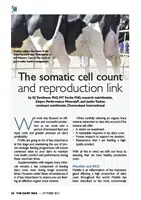Healthy udders like these of the Adderley herd near Philadelphia in the Western Cape is the result of good udder health management.
We must stay focused on efficient and successful production as we move into a period of increased feed and input costs and greater pressure on dairy profitability. Profits are going to be of key importance at this stage and maintaining the use of proven strategic feeding programmes will ensure continued value to your dairy to maintain cow health, comfort and performance during these uncertain times. Supplementation with organic trace minerals remains a key component of feeding dairy cows, even during tough economic times. However, under these circumstances, it is of key importance to ensure you are feeding an effective organic trace mineral. When carefully selecting an organic trace mineral, remember to take into account if the mineral will offer:- A return on investment.
- A repeatable response in my dairy cows.
- Proven research to support my decision.
- Reassurance that I am feeding a highquality product.
Mastitis and SCC
Mastitis is an inflammation of the mammary gland affecting a high proportion of dairy cows throughout the world. Mastitis has been described as the most economically imposing disease facing the dairy producer as it decreases milk production and alters milk composition. When bacteria invade the mammary gland, they multiply and produce harmful substances that result in an inflammatory response (inflammatory mediators). Somatic cells in milk are an indication of the activity of the immune defense system to protect the mammary gland against infection. Milk from healthy udders exhibits a somatic cell count (SCC) that varies between 18 000 and 200 000 cells/ml. Cows with subclinical mastitis can have an SCC of up to a few million cells/ml. Mastitis has been implicated in decreasing reproductive performance. Research in the last 10-20 years has shown that cows with an elevated SCC are much more likely to suffer early embryonic death or reproduction failure than animals not experiencing an immune challenge. Both gram-negative (like E.coli) and grampositive (like Streptococcus and Staphylococcus aureus) bacteria, as well as their inflammatory mediators, can reduce conception rates and cause early embryonic losses. Researchers have shown that the onset of clinical mastitis before first service increased the number of days to first service and days open. Services per conception and days open were also increased in cows when clinical mastitis occurred between first service and conception. The effect of subclinical mastitis in early lactation (first 90 days) is equal to clinical mastitis in its negative effect on reproductive performance. It is most severe when the subclinical infections develop into clinical cases. Each day an animal fails to establish pregnancy after 90 days is associated with a monetary loss due to decreased milk production, altered milk composition, treatment costs, discarded milk and increased culling rates.Mineral magic
Trace minerals are key components in the chain of events responsible for the clearing of foreign materials in the mammary gland leading to mastitis events. Thus, improving trace mineral availability leads to a shorter duration of mastitis infections and/or inflammation. Zinc, copper, manganese and selenium play critical roles in skin and mammary health, somatic cell count function and disease resistance (immunity). Careful consideration and assessment should be given to supplementation of trace minerals before and during immune challenges. It is not worth removing proven organic trace minerals from the cow’s diet in order to save costs as the negative effects of an insufficiency or imbalance later will reduce performance and may delay recovery.Performance minerals
Zinpro Performance Minerals® offers Availa®4, which is a combination of zinc, manganese and copper as complex aminoacid trace minerals together with cobalt glucoheptonate. Research-proven results from over 40 peer reviewed dairy studies shows consistent performance benefits. Optimal effects were shown when supplementation began during the dry period and resulted in a 14,9% reduction in SCC and improved reproductive performance (in-calf 13 days earlier), together with increased milk production and improvements in hoof health. Zinpro and Chemuniqué are committed to improving the reproductive performance success of dairy cows and heifers through quality trace-mineral supplementation. This will ultimately lead to the goal of a performance bonus. Talk to your nutritionist or feed sales representative about the inclusion of Zinpro Performance Minerals® in the diet of your cows and calves.Chemuniqué empowers feed and food producers with the most innovative animal performance solutions, enabling our clients to consistently advance the efficiency of production.









